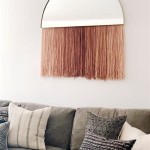How Do You Hang a Mirror on Tile Without Drilling?
Hanging a mirror on tile presents a unique challenge due to the hard, smooth surface that makes traditional drilling difficult and potentially damaging. Fortunately, several effective methods allow for secure mirror installation without the need for drilling. These methods utilize specialized adhesives, strong suction cups, and innovative hanging systems designed specifically for smooth surfaces.
Adhesive-Based Solutions
Adhesive solutions are a popular choice for hanging mirrors on tile due to their ease of use and relatively strong holding power. Several types of adhesives are suitable for this purpose:
1. Construction Adhesive: Heavy-duty construction adhesives, often used for bonding various building materials, can provide a secure hold for mirrors. Ensure the adhesive chosen is explicitly compatible with both tile and the backing of the mirror.
2. Mirror Mastic: Mirror mastic is specifically formulated for adhering mirrors to smooth surfaces like tile. It provides a strong, long-lasting bond and often features a grab adhesive to hold the mirror in place while the mastic cures.
3. Mounting Tape: Double-sided mounting tape designed for heavy objects offers a convenient, no-mess alternative. Select a tape specifically rated for the weight of the mirror being hung.
When using adhesive methods, proper surface preparation is crucial. Clean the tile surface thoroughly with a suitable cleaner to remove any dust, grime, or soap residue. A clean surface ensures optimal adhesion. Depending on the adhesive chosen, a primer may improve bonding further.
Suction Cup Hangers
Suction cup hangers offer a readily available and removable solution for lighter mirrors. These hangers use powerful suction cups to adhere to smooth surfaces like tile.
1. Weight Capacity: Carefully check the weight capacity of the suction cup hangers to ensure they can safely support the weight of the mirror.
2. Surface Compatibility: Verify the suction cups are designed for use on non-porous surfaces like tile.
3. Proper Installation: Clean the tile surface thoroughly before attaching the suction cups. Follow the manufacturer’s instructions for proper installation, which typically involves pressing the suction cups firmly against the tile to create a vacuum seal.
While convenient, suction cup hangers are generally recommended for smaller, lighter mirrors. For larger or heavier mirrors, alternative methods offer greater security.
Specialized Hanging Systems
Several specialized hanging systems are designed specifically for mounting items on tile without drilling. These systems employ various mechanisms to provide secure and damage-free installation.
1. Adhesive Tracks: These systems involve applying an adhesive track to the tile and then attaching clips or hooks to the track. The mirror is then hung from these clips or hooks.
2. Tension-Based Systems: Utilizing a spring-loaded mechanism, tension-based systems can secure a mirror between the floor and ceiling without requiring any permanent attachment to the tile.
3. Clamping Systems: Some systems clamp onto the edge of the tile, providing a secure point for hanging the mirror. This method may be suitable for thinner tiles with sufficient edge overhang.
Specialized hanging systems offer a versatile approach for various mirror sizes and weights. Evaluating the specific features and weight limits of each system before choosing is essential.
Preparing the Tile Surface
Regardless of the chosen hanging method, proper surface preparation is critical for successful mirror installation. A clean, smooth surface optimizes adhesion and ensures a secure bond.
1. Cleaning: Clean the tile thoroughly with a suitable cleaner, such as isopropyl alcohol or a specialized tile cleaner, to remove any dirt, grease, or soap residue.
2. Drying: Allow the tile surface to dry completely before applying any adhesive or mounting hardware.
3. Primer (Optional): Depending on the adhesive and tile surface, applying a primer may enhance adhesion.
Weight Considerations
Choosing a suitable hanging method always involves considering the weight of the mirror. Heavier mirrors require more robust solutions.
1. Mirror Weight: Accurately determine the weight of the mirror before selecting a hanging method.
2. Method Capacity: Verify the weight capacity of the chosen method, whether adhesive, suction cups, or a specialized system, exceeds the mirror's weight.
Safety Precautions
Safety should always be paramount when handling and installing mirrors.
1. Eye Protection: Wear safety glasses to protect eyes from potential debris or adhesive splatter.
2. Gloves: Wear gloves when handling adhesives to protect skin.
3. Proper Ventilation: Ensure adequate ventilation when working with adhesives or cleaning solutions.
Choosing the Right Method
Selecting the most appropriate method for hanging a mirror on tile without drilling depends on several factors:
1. Mirror Weight: Lighter mirrors may be suitable for suction cups or adhesive tape, while heavier mirrors require stronger adhesives or specialized hanging systems.
2. Tile Type: Some adhesives and hanging systems may be better suited for certain tile types.
3. Desired Permanence: Consider whether the mirror installation needs to be permanent or removable.
By carefully considering these factors and following the appropriate installation instructions, a mirror can be securely and effectively hung on tile without drilling, preserving the integrity of the tiled surface.

How To Hang A Mirror On Tile Wall Remington Avenue

How To Hang Mirrors On Tile 3 Ways A Bonus The Palette Muse

How To Hang Mirrors On Tile 3 Ways A Bonus The Palette Muse

How To Hang A Mirror On Tile Wall Remington Avenue

3 Simple Ways To Hang A Mirror On Wall Without Nails Wikihow

How To Hang Mirrors On Tile 3 Ways A Bonus The Palette Muse

Mirror Without Drilling Tesa

How To Mount Mirrors On Tile Walls Without Drilling Tesa

How To Mount Bathroom Accessories On Tiles Without Drilling Velcro Brand

How To Hang A Mirror On Wall Without Nails








